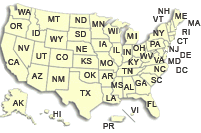Watershed delineation at Fort Bragg, North Carolina, using LIDAR data
Poster for USGS/Department of Defense Environmental Conservation Program, Charleston, S.C., May 1-4, 2001
By B.M. Wrege and Michelle Cienek
Download PowerPoint version of the poster (2 MB)
Abstract
In order to develop best management practices for Industrial Areas and to effectively manage their watersheds, Fort Bragg requires digital information on elevations, drainage basins, stormwater conveyance systems, streamflow, and existing manmade and natural features. This information will be used to develop a stormwater drainage basin runoff model. The stormwater basin model will serve many applications, including the evaluation of areas of high load erosion events, tracking non-point source pollution, and planning for future development on base. This pilot study focuses on the effectiveness of using LIDAR (Light Interferometric Distance and Ranging) data to develop an urban stormwater drainage basin model. LIDAR data are acquired with aircraft-mounted lasers. Aerial topographic surveys produced from the LIDAR data provide high-resolution land surface elevations. GIS data, supplemented with aerial photography and LIDAR data, are used to model the areas flowing into industrial outfall 53, a water quality sampling site. The pollutants sampled in the runoff at outfall 53 can be linked to the associated Industrial Area, Area 3-3.
The LIDAR data consists of points spaced at five-meter intervals with a longitudinal, latitudinal and vertical accuracy within a measured 35 centimeters in all three dimensions. These data will allow for the creation of a digital elevation model (DEM) with a five-meter cell size that can be utilized to predict the flow accumulation and flow direction within each cell. For the pilot study, the elevation of the road and curb were raised slightly to create a DEM and a flowdirection model that account for the influence of manmade structures. Next, a map linking all known stormdrains and outfalls was digitized and the stormdrains were adjusted to fit within the cell of highest flow accumulation. The area upgradient of the stormdrains is delineated to create a predictive model of the overland flow to outfall 53. The estimated area flowing into outfall 53 by the computer model is 22.3 acres. A USGS hydrologist delineated a drainage area of 24 acres flowing into outfall 53 during field visits to the site. Close examination of the final flow map shows a few areas between the stormdrains that are not captured in the model. This relates to the flatness of the area at these points. The model does not have the sensitivity to account for this lack of elevation difference. Slight variances in elevation could not be discriminated using the LIDAR data. The next step in this pilot study will be to include the influence of pervious/impervious land cover. In conclusion, when working with very small areas with moderate to little elevation change, LIDAR data with five-meter spacing can provide a useful tool in predicting urban runoff and watershed delineation, but the resolution still may be too large to predict small variances in the landscape.
Citation:
Wrege, B.M., and Cienek, Michelle, 2001, Watershed delineation at Fort Bragg, North Carolina, using LIDAR data [poster]: USGS/Department of Defense Environmental Conservation Program, Charleston, S.C., May 1-4, 2001.
|
For more information, contact |
To order printed copies, contact |
North Carolina Water Science Center
U.S. Geological Survey
3916 Sunset Ridge Road
Raleigh, North Carolina 27607
(919) 571-4000
E-mail
|
North Carolina Water Science Center
U.S. Geological Survey
3916 Sunset Ridge Road
Raleigh, North Carolina 27607
(919) 571-4037
E-mail
|
U.S. Geological Survey
Information Services
Box 25286, Federal Center
Denver, CO 80225
1-888-ASK USGS
|
|
